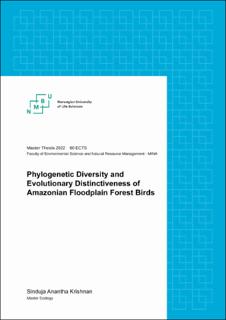| dc.contributor.advisor | Haugaasen, Torbjørn | |
| dc.contributor.author | Anantha Krishnan, Sinduja | |
| dc.coverage.spatial | South America | en_US |
| dc.date.accessioned | 2022-12-19T11:36:04Z | |
| dc.date.available | 2022-12-19T11:36:04Z | |
| dc.date.issued | 2022 | |
| dc.identifier.uri | https://hdl.handle.net/11250/3038479 | |
| dc.description.abstract | The Amazon basin contains one-fifth of all free-flowing fresh water on the planet and is home to the largest tropical rainforest on Earth. However, the region is not homogenous and is interspersed with several different forest types. Floodplain forests are formed from the seasonal rainfall that spills over the banks of the rivers and inundate vast areas. In the Amazon basin, várzea are formed from the whitewater rivers that carry sediment eroded from the Andes and deposited on the floodplains. They are the most fertile of the floodplain forest types. Forests inundated on a seasonal basis by either black- or clear-water rivers are collectively known as igapó. They are of lower fertility than várzea. The differences in floristic composition of the floodplain forests affects the faunal composition.
There is a high species richness of birds in the floodplain forests due to the availability of resources such as fruits, flowers, insects, habitat niches and special foraging substrates. To examine the richness, I used the indices of Phylogenetic Diversity to calculate the amount of evolutionary history and Evolutionary Distinctiveness, to find the most evolutionarily unique species from a compiled list of floodplain forest bird species.
The results show that the seasonally flooded forests contain some species of very early origin and many species of more recent origin. Species that have a long evolutionary history are some of the most evolutionarily unique species and are the only representatives of a single family. This therefore offers an opportunity to examine if conservation efforts are sufficiently protecting evolutionarily unique species.
Disturbance of the flood pulse in the Amazonian floodplains through infrastructure development (e.g., hydroelectric dams) or global climate change (in the form of extreme floods or droughts) can pose a serious threat to the ecology of the seasonally flooded forests across Amazonia. There is, therefore, a pressing need to better our understanding of biodiversity patterns and community assemblages across the Amazonian floodplains. | en_US |
| dc.language.iso | eng | en_US |
| dc.publisher | Norwegian University of Life Sciences, Ås | en_US |
| dc.rights | Attribution-NonCommercial-NoDerivatives 4.0 Internasjonal | * |
| dc.rights.uri | http://creativecommons.org/licenses/by-nc-nd/4.0/deed.no | * |
| dc.subject | Diversity | en_US |
| dc.subject | Birds | en_US |
| dc.subject | Amazonas | en_US |
| dc.title | Phylogenetic diversity and evolutionary distinctiveness of Amazonian floodplain forest birds | en_US |
| dc.type | Master thesis | en_US |
| dc.description.localcode | M-ECOL | en_US |

